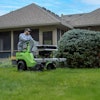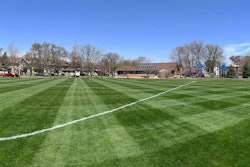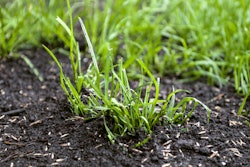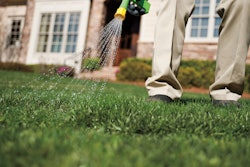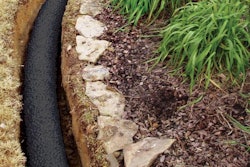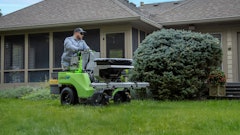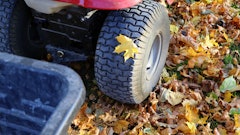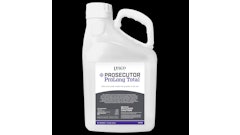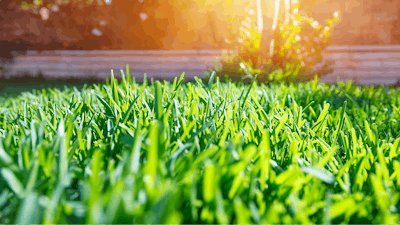
As winter fades away, property owners are eager to get their natural turf lawns revitalized and in top form for warmer months ahead. Whether surrounding a home or a business, a well-maintained and lush lawn sets the tone and makes a critical first impression.
If winter weather has taken its toll on natural turf, some extra care may be required to help it recover quickly. Consider adding some near-term actionable steps to a spring lawn care package for new clients, or upsell existing clients beyond a month-to-month maintenance plan.
Assess and address moss
As the growing season for turfgrass winds down, the growing season for moss takes off. From fall until early spring, conditions that may weaken grass and create bare patches — such as less sunlight, more shade, poor irrigation, fewer nutrients, high acidity and increasing thatch — set the right foundation for moss to take hold.
A dense and healthy lawn is the best defense against moss, but if moss is present, some steps in early spring can help get it under control. First, consider whether enough sunlight is reaching the turf and suggest where trees can be thinned or pruned to allow more light through. Then, determine whether moss has found a foothold in thatch, and if so, dethatch to give turf a better chance to thrive.
Next, test soil samples to learn of any pH imbalances or nutrient deficiencies. Some amendments may be needed in the soil to create more favorable conditions for turfgrass — and a more hostile environment for moss in the process. Finally, once the soil is prepped, reseed bare patches to achieve even cover.
Conduct spring revitalization services
Consider providing clients with a spring walk-through of their lawn’s conditions, offering to remedy any issues from a suite of spring revitalization services. For instance, during winter months, thatch can build up beyond the recommended thickness of about half an inch. As organic matter builds and becomes compacted, it can lead to problems beyond moss, such as pests, fungal growth and root rot. Depending on the size of the lawn and the area impacted, dethatching may be handled most efficiently with a lawn dethatcher or power rake. If the problem is minimal, then some hand raking may be enough.
While checking for thatch, consider the level of soil compaction. The older that turf becomes and the more traffic it entertains, the more likely it is for topsoil to become compacted. Such a condition can prevent water, air and nutrients from reaching turfgrass roots, depriving them of the essentials for healthy growth. Aerating the soil — removing plugs of dirt at regular intervals — helps prepare lawns for spring, as the loosened soil allows water, air and fertilizer in, and it is in better condition to receive seed should reseeding be necessary.
Note any bare or worn patches in a lawn, or areas that look thin, and suggest interseeding to fill them in. In addition to enhancing the overall appearance of the lawn, interseeding will help keep turf dense, which is a natural defense to keeping weeds out.
Revisit mowing and irrigation practices
Use an early spring walk-through as an opportunity not only to educate clients about developing issues, but to revisit their mowing and irrigation practices so they understand their part in nurturing a healthy lawn between maintenance visits.
In some areas, spring rains and sunshine can send natural turf on a rapid growth spurt. While it may be tempting to cut grass short if it has grown too tall, remind property owners that cutting too short in one session can stress the grass and deplete its energy reserves. As a result, turfgrass’s resistance to weeds and pests may be weakened. Instead, recommend cutting no more than one-third the height of the grass blade at once. In some instances, more frequent mowing may be recommended, such as twice a week in spring.
Spring is also a good time to inspect irrigation systems to ensure they are in proper working order. Property owners will want their system to deposit large drops close to the ground for the most efficient and effective watering, as systems that release a fine mist may lose more to evaporation and movement from air currents. Maintaining a regular watering schedule is best for grass, and deep watering once or twice a week is generally sufficient. If possible, get clients to commit to a schedule, such as by setting their system on a timer.
Serve as a valuable resource year-round
Natural turf can be a stunning choice for landscaping needs, but it’s important to know and understand how changing seasons impact its health and appearance. By providing clients with actionable steps at key points of the year, landscape professionals serve as valuable partners in maintaining a property’s aesthetics year-round.
Grass Seed USA is a national coalition of grass seed farmers and academic turf specialists with a wealth of experience in studying, growing and harvesting grass and grass seed. The coalition seeks to inform and educate residential and commercial customers about the benefits of grass and best practices for responsibly growing and maintaining healthy turf. For more information, visit www.weseedamerica.com or follow @WeSeedAmerica on Facebook and Twitter.

